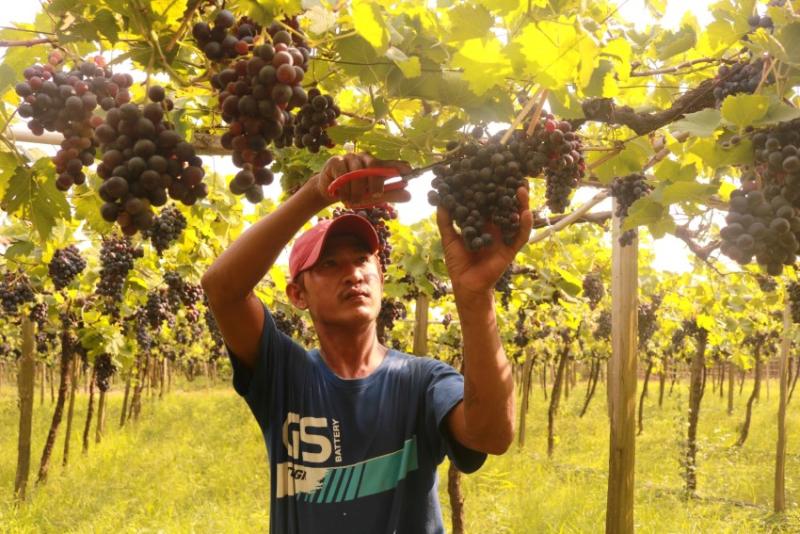YAMETHIN, Mandalay Region — Workers prised grapes from rows trained on Y-shaped trellises, loading them into their baskets, while vehicles weighted with lugs of fresh grapes left the vineyard one by one.
Myanmar Now came across this busy scene while visiting Yamethin Township of Mandalay Region, in Burma’s central Dry Zone, in May.
Two types of grape are nurtured in the sprawling vineyards of the township. One is sold fresh to fruit wholesalers, the other is sent for pressing in wineries.
Grower San Aung in Alaykon village said the advantages of growing grapes for wine included the money saved on transport, because the wine companies come right to the vineyard to buy grapes.
“It is not difficult to grow more wine grapes if the first batch goes well. If all goes well, I won’t need to grow other crops,” he said.
Like San Aung, local growers are increasingly selling to wine companies to meet a steadily growing demand.
Burma’s drinkers currently prefer beer or spirits, but wine producers are hopeful that wine enjoyment will keep growing steadily from its low base. Supermarkets in larger cities are stocking an increasing number of locally made wines. Tourists may also be tempted to dabble if more local wine were made available.
Myanmar 1st Vineyard Estate started growing grapes near Taunggyi, the capital of Shan State, in the year 2000. Six years later, the first bottles reached the market. Its Aythaya and Monte Vino-branded red, white and rosé wines are now sold across Burma. Its Aythaya vineyard is also a popular tourist stop, with a scenic dining terrace.
According to the 2017 Shan State Investment Survey Report published by the finance ministry in 2017, the company began exporting wines to foreign markets in 2009.
Currently, the company grows 14 grape varieties based on vines imported from Europe. Growth in sales led to partnerships with grape growers in Yamethin and Meiktila townships of Mandalay Region, as well as Hopong Township, also in Shan State.
Seventeen local growers banded together to grow grapes over 20 acres in Yamethin Township, partly to supply the company. More have since joined the effort, bringing the number to 30, according to the company’s deputy product director, Min Zaw Thant. He added that, in a few years, the company would bar new entrants to the partnership.
Nyo Gyi, a grower in Yamethin, has worked with the company for eight years. He said a third of the grapes harvested from his 4.5-acre vineyard now goes to the winery.
[related]
He said locals prefer to grow grapes for wine because of the more stable prices. The price for a viss (1.63 kilogrammes) of grapes is generally between 2,000 and 3,000 kyats ($1.44-2.16). However, the price of grapes grown to be eaten fresh can sometimes fall to 800 kyats ($0.58) per viss if misshapen.
Grapes grown for fresh consumption fetch attractive prices only if large and perfectly shaped. This requires extra care, and correspondingly higher costs, in contrast with grapes destined for a wine press.
According to the Yamethin Agriculture Department, there are 3,083 acres of vineyard in the township, but local growers estimate the real number to be double.
Tin Oo, a local bean grower, has also cultivated grapes for 30 years, for fresh consumption and, increasingly, for wine. He too cited the lower costs of growing wine grapes.
However, despite the relative ease of cultivation and attractive prices, demand from wineries is still limited and growers make themselves vulnerable by depending on one company, which some locals worry may one day cut down on purchases.
Moreover, while grapes for fresh consumption can be grown twice a year, those intended for wineries can only be grown once a year. This can impose a burdensome delay on farmers receiving their first returns.
Yet, growers are seeing a slowly increasing number of buyers. Owners of small wineries in Pyin Oo Lwin, further north in Mandalay Region, and elsewhere are coming to their vineyards to buy grapes, and a winery in the capital Naypyidaw has proposed a partnership with Yamethin growers.
Some wineries are providing growers with free vines to ensure quality, and one company is offering loans worth up to 30 percent of the expected yield, without interest, to new growers.
Myanmar 1st Vineyard Estate, meanwhile, is planning to scale up production. It currently produces around 350,000 wine bottles a year. But the company anticipates 400,000 bottles next year and estimates that, in a few years, they could hit 600,000 bottles.
According to a survey by the company, wine drinkers account for a negligible 0.0005 percent of Burma’s population, or 26,445 people. However, they say their sales have increased by around 10 percent year-on-year for the past five years.
“People will keep on drinking wine. Wine culture is always on the rise,” said Min Zaw, the company’s deputy product director.
This story was originally published by Myanmar Now.



